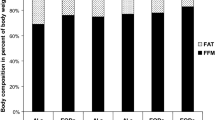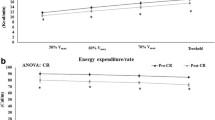Abstract
Aging decreases the normal organism physiological functions. On the other hand, physical exercise shows health benefits, but little information is known about physical deconditioning at aging. The aim of the present study was to analyze the glucose muscle metabolism in middle-age Wistar rats in response to conditioning and physical deconditioning. The study included three groups: Control (C)—not performed physical training; Trained (T)—performed physical training from 4 to 12 months—swimming exercise for 1 h per day, 5 days per week at 80% of maximal lactate stead state—MLSS; Detrained (D)—performed to physical training from 4 to 8 months and assessed at 12 months (D). Physical training at submaximal intensities induced decreases in body weight (C 588 ± 71, T 515 ± 72, D 576 ± 62 g), and the weight of mesenteric adipose tissue (C 4399 ± 643, T 3007 ± 811, D 4085 ± 540 mg/g), and increases in exercise workload in MLSS intensity (C 4.6 ± 0.4, T 5.8 ± 1.3, D 5.3 ± 0.4% body weight), glucose tolerance (C 12314 ± 1122, T 8428 ± 853, D 9433 ± 1200 mg/dL 120 min), glycogen deposits (C 0.48 ± 0.07, T 0.66 ± 0.18, D 0.46 ± 0.10 mg/100 mg) and glucose uptake by skeletal muscle (C 1.96 ± 0.54, T 3.28 ± 0.53, D 2.55 ± 0.35 μmol/g/h) in trained animals. Additionally, the improvement in exercise load in MLSS, glucose tolerance and glucose uptake was maintained after physical detraining. In summary, the physical training promotes alterations in body weight, fat tissue, aerobic capacity and muscular glucose metabolism in middle-age rats. However, only the aerobic capacity and muscular glucose metabolism were maintained after detraining.
Similar content being viewed by others
Abbreviations
- VO2max:
-
Maximum oxygen consumption
- MLSS:
-
Maximum lactate steady state
- GLUT:
-
Glucose transporter
- GTT:
-
Glucose tolerance test
- ITT:
-
Insulin tolerance test
References
Mazur-Bialy AI, Pocheć E (2017) Vitamin B2 deficiency enhances the pro-inflammatory activity of adipocyte, consequences for insulin resistance and metabolic syndrome development. Life Sci 178:9–16
Xu H, Barnes GT, Yang Q, Tan G, Yang D, Chou CJ et al (2003) Chronic inflammation in fat plays a crucial role in the development of obesity-related insulin resistance. J Clin Invest 112(12):1821–1830
Weisberg SP, McCann D, Desai M, Rosenbaum M, Leibel RL, Ferrante AW (2003) Obesity is associated with macrophage accumulation in adipose tissue. J Clin Invest 112(12):1796–1808
Andersen CJ, Murphy KE, Fernandez ML (2016) Impact of obesity and metabolic syndrome on immunity. Adv Nutr 7(1):66–75
Rocha-Rodrigues S, Rodríguez A, Gonçalves IO, Moreira A, Maciel E, Santos S et al (2017) Impact of physical exercise on visceral adipose tissue fatty acid profile and inflammation in response to a high-fat diet regimen. Int J Biochem Cell Biol 87:114–124
Botezelli JD, Mora RF, Dalia RA, Moura LP, Cambri LT, Ghezzi AC et al (2010) Exercise counteracts fatty liver disease in rats fed on fructose-rich diet. Lipids Health Dis 9:116
Botezelli JD, Cambri LT, Ghezzi AC, Dalia RA, Scariot PP, Ribeiro C et al (2011) Different exercise protocols improve metabolic syndrome markers, tissue triglycerides content and antioxidant status in rats. Diabetol Metab Syndr 3:35
Liu S, Du F, Li X, Wang M, Duan R, Zhang J, Wu Y, Zhang Q (2017) Effects and underlying mechanisms of irisin on the proliferation and apoptosis of pancreatic β cells. PLoS One 10:12
Issurin V (2008) Block periodization versus traditional training theory: a review. J Sports Med Phys Fit 48:65–75
de Araujo GG, Papoti M, Dos Reis IG, de Mello MA, Gobatto CA (2012) Physiological responses during linear periodized training in rats. Eur J Appl Physiol 112:839–852
Hayes JP, Chappell MA (1990) Individual consistency of maximal oxygen consumption in deer mice. Funct Ecol 4:495–503
Xie B, Yan X, Cai X, Li J (2017) Effects of high-intensity interval training on aerobic capacity in cardiac patients: a systematic review with meta-analysis. Biomed Res Int 2017:5420840
Carmeli E, Merrick J, Kessel S, Masharawi Y, Carmeli V (2003) Elderly persons with intellectual disability: a study of clinical characteristics, functional status, and sensory capacity. Sci World J 3:298–307
Bergstrom J, Hermansen L, Hultman E, Saltin B (1967) Diet, muscle glycogen and physical performance. Acta Physiol Scand 71:140–150
Ghanbari-Niaki A, Kraemer RR, Abednazari H (2011) Time-course alterations of plasma and soleus agouti-related peptide and relationship to ATP, glycogen, cortisol, and insulin concentrations following treadmill training programs in male rats. Horm Metab Res 43(2):112–116
Jensen J, Lai YC (2009) Regulation of muscle glycogen synthase phosphorylation and kinetic properties by insulin, exercise, adrenaline and role in insulin resistance. Arch Physiol Biochem 115(1):13–21
Jensen TE, Richter EA (2012) Regulation of glucose and glycogen metabolism during and after exercise. J Physiol 590(5):1069–1076
Jensen J, Rustad PI, Kolnes AJ, Lai YC (2011) The role of skeletal muscle glycogen breakdown for regulation of insulin sensitivity by exercise. Front Physiol 2:112
Sjøberg KA, Frøsig C, Kjøbsted R, Sylow L, Kleinert M, Betik AC et al (2017) Exercise increases human skeletal muscle insulin sensitivity via coordinated increases in microvascular perfusion and molecular signaling. Diabetes 66(6):1501–1510
Luciano E, Carneiro EM, Carvalho CR, Carvalheira JB, Peres SB, Reis MA et al (2002) Endurance training improves responsiveness to insulin and modulates insulin signal transduction through the phosphatidylinositol 3-kinase/Akt-1 pathway. Eur J Endocrinol 147(1):149–157
Gobatto CA, de Mello MA, Sibuya CY, de Azevedo JR, dos Santos LA, Kokubun E (2001) Maximal lactate steady state in rats submitted to swimming exercise. Comp Biochem Physiol A Mol Integr Physiol 130(1):21–27
Pavlik G (1985) Effects of physical training and detraining on resting cardiovascular parameters in albino rats. Acta Physiol Hung 66(1):27–37
Heck H, Mader A, Hess G, Mücke S, Müller R, Hollmann W (1985) Justification of the 4-mmol/l lactate threshold. Int J Sports Med 6(3):117–130
Cinti S, Mitchell G, Barbatelli G, Murano I, Ceresi E, Faloia E et al (2005) Adipocyte death defines macrophage localization and function in adipose tissue of obese mice and humans. J Lipid Res 46(11):2347–2355
Dubois M, Gilles KA, Hamilton JK, Rebers PA, Smith F (1956) Colorimetric method for determination of sugars and related substances. Anal Chem 28:350–356
Franchini E, Branco BM, Agostinho MF, Calmet M, Candau R (2015) Influence of linear and undulating strength periodization on physical fitness, physiological, and performance responses to simulated judo matches. J Strength Cond Res 29(2):358–367
Prestes J, da Cunha Nascimento D, Tibana RA, Teixeira TG, Vieira DC, Tajra V et al (2015) Understanding the individual responsiveness to resistance training periodization. Age (Dordr) 37(3):9793
Mazzucatto F, Higa TS, Fonseca-Alaniz MH, Evangelista FS (2014) Reversal of metabolic adaptations induced by physical training after two weeks of physical detraining. Int J Clin Exp Med 7(8):2000–2008
Ormsbee MJ, Arciero PJ (2011) Detraining increases body fat and weight and decreases VO2 peak and metabolic rate. J Strength Cond Res 26(8):2087–2095
Pauli JR, Ropelle ER, Cintra DE, De Souza CT, da Silva AS, Moraes JC et al (2010) Acute exercise reverses aged-induced impairments in insulin signaling in rodent skeletal muscle. Mech Ageing Dev 131(5):323–329
Pauli JR, Leme J, Crespilho D, Mello MA, Rogatto G, Luciano E (2005) Influence of physical training on the parameters of the adrenal hypothalamic pituitary axis of rats treated with dexamethasone. Rev Port Cien Desp 2:143–152
Geirsdottir OG, Arnarson A, Briem K, Ramel A, Jonsson PV, Thorsdottir I (2012) Effect of 12-week resistance exercise program on body composition, muscle strength, physical function, and glucose metabolism in healthy, insulin-resistant, and diabetic elderly Icelanders. J Gerontol A Biol Sci Med Sci 67(11):1259–1265
Knowler WC, Barrett-Connor E, Fowler SE, Hamman RF, Lachin JM, Walker EA et al (2002) Reduction in the incidence of type 2 diabetes with lifestyle intervention or metformin. N Engl J Med 346(6):393–403
Barbosa de Queiroz K, Honorato-Sampaio K, Rossoni Júnior JV, Andrade Leal D, Pinto AB, Kappes-Becker L et al (2017) Physical activity prevents alterations in mitochondrial ultrastructure and glucometabolic parameters in a high-sugar diet model. PLoS One 12(2):e0172103
Farah D, Nunes J, Sartori M, Dias DD, Sirvente R, Silva MB et al (2016) Exercise training prevents cardiovascular derangements induced by fructose overload in developing rats. PLoS One 11(12):e0167291
Fidalgo M, Falcão-Tebas F, Bento-Santos A, de Oliveira E, Nogueira-Neto JF, de Moura EG et al (2013) Programmed changes in the adult rat offspring caused by maternal protein restriction during gestation and lactation are attenuated by maternal moderate-low physical training. Br J Nutr 109(3):449–456
Marschner RA, Pinto G, Borges J, Markoski MM, Schaan BD, Lehnen AM (2017) Short-term detraining does not change insulin sensitivity and RBP4 in rodents previously submitted to aerobic exercise. Horm Metab Res 49(1):58–63
Santos AP, Marinho DA, Costa AM, Izquierdo M, Marques MC (2012) The effects of concurrent resistance and endurance training follow a detraining period in elementary school students. J Strength Cond Res 26(6):1708–1716
Ferreira JC, Rolim NP, Bartholomeu JB, Gobatto CA, Kokubun E, Brum PC (2007) Maximal lactate steady state in running mice: effect of exercise training. Clin Exp Pharmacol Physiol 34(8):760–765
Lo MS, Lin LL, Yao WJ, Ma MC (2011) Training and detraining effects of the resistance vs. endurance program on body composition, body size, and physical performance in young men. J Strength Cond Res 25(8):2246–2254
Theodorou AA, Panayiotou G, Volaklis KA, Douda HT, Paschalis V, Nikolaidis MG et al (2016) Aerobic, resistance and combined training and detraining on body composition, muscle strength, lipid profile and inflammation in coronary artery disease patients. Res Sports Med 24(3):171–184
Mitsuhashi T, Yamada C, Iida A, Hiratsuka N, Inabe F, Araida N et al (2011) Long-term detraining increases the risk of metabolic syndrome in Japanese men. Tokai J Exp Clin Med 36(4):95–99
Vogler CM, Menant JC, Sherrington C, Ogle SJ, Lord SR (2012) Evidence of detraining after 12-week home-based exercise programs designed to reduce fall-risk factors in older people recently discharged from hospital. Arch Phys Med Rehabil 93(10):1685–1691
Coetsee C, Terblanche E (2015) The time course of changes induced by resistance training and detraining on muscular and physical function in older adults. Eur Rev Aging Phys Act 12:7
Joo CH (2016) The effects of short-term detraining on exercise performance in soccer players. J Exerc Rehabil 12(1):54–59
Acknowledgements
We are grateful to the São Paulo Research Foundation (FAPESP Process No. 2010/12896-0). We thank José Roberto R. Silva for technical assistance. This manuscript was translated for proper English Language by native speaking editors at American Journal Experts.
Author information
Authors and Affiliations
Corresponding author
Ethics declarations
Conflict of interest
The authors declare that they have no competing interests.
Ethical approval
All procedures performed in studies were in accordance with the ethical standards of the institutional and/or national research committee. All procedures were approved by the University Research Ethics Committee.
Informed consent
For this type of study, formal consent is not required.
Rights and permissions
About this article
Cite this article
Ghezzi, A.C., Cambri, L.T., Botezelli, J.D. et al. Muscular glucose metabolism in middle-age trained rats. Sport Sci Health 13, 527–533 (2017). https://doi.org/10.1007/s11332-017-0377-2
Received:
Accepted:
Published:
Issue Date:
DOI: https://doi.org/10.1007/s11332-017-0377-2




